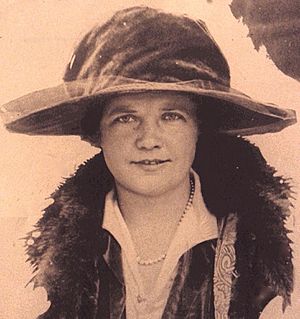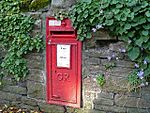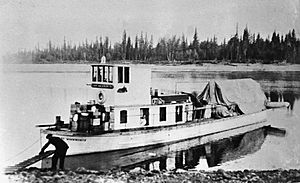Margaret Haig Thomas, 2nd Viscountess Rhondda facts for kids
Margaret Haig Mackworth, 2nd Viscountess Rhondda (born Thomas; 12 June 1883 – 20 July 1958) was an important Welsh noblewoman and businesswoman. She was also a strong supporter of women's right to vote and played a big part in the history of women's suffrage in the UK.
Contents
Early Life and Education
Margaret Haig Thomas was born in London on June 12, 1883. Her father was David Alfred Thomas, a businessman and politician. Her mother, Sybil Haig, was also a suffragette. Margaret wrote in her book that her mother really wanted her daughter to become a feminist. Margaret did become a passionate activist for women's rights.
She was an only child and grew up at Llanwern House, near Newport. When she was 13, she went to boarding school. She first attended Notting Hill High School and then St Leonards School in St Andrews.
In 1904, at age 19, she started studying history at Somerville College, Oxford. Even though her teachers said she was doing well, she returned home after two terms. She then worked for her father at his company in Cardiff Docks.
Fighting for Women's Vote
In 1908, when she was 25, Margaret married Humphrey Mackworth. That same year, she joined the Women's Social and Political Union (WSPU). This group worked to get women the right to vote. She became the secretary of the WSPU branch in Newport.
From 1908 to 1914, she campaigned for women's right to vote across South Wales. She often spoke at meetings where people were against her ideas. Margaret took part in protest marches with the Pankhursts, who were famous leaders of the suffragette movement. She even jumped onto the car of Prime Minister H. H. Asquith in St Andrews.
Margaret felt that being part of the women's suffrage movement gave her adventure and excitement. She said it was like a "draft of fresh air" in her "padded, stifled life."
In June 1913, Margaret tried to set fire to a Royal Mail letter-box. She used a chemical bomb to try and make her WSPU branch more active. She was put on trial and refused to pay a £10 fine. She was sentenced to one month in jail. However, she was released after only five days because she went on a hunger strike.
The WSPU gave Margaret a Hunger Strike Medal for her bravery.
After Emmeline Pankhurst, a key suffragette leader, died in 1928, Margaret helped arrange memorials for her. They raised money for Pankhurst's gravestone and a statue of her outside the House of Commons.
World War I and the Lusitania
When the First World War started, Margaret agreed with the WSPU's decision to stop their protests for suffrage. She was working as her father's trusted secretary. Her father believed in her greatly and had discussed important matters with her since she was young.
She traveled with her father to the United States. He was sent by David Lloyd George to arrange for military supplies for Britain.
On May 7, 1915, Margaret was returning from the United States on the ship RMS Lusitania. Her father and his secretary were also with her. A German submarine, U-20, torpedoed the ship. Margaret's father and his secretary were blown overboard and got onto a lifeboat. Margaret clung to a piece of wood for a long time before being rescued by an Irish fishing boat called "Bluebell." She wrote about this in her 1933 book, This Was My World. She was unconscious from hypothermia when she was rescued. After staying in the hospital, she spent several months recovering at her parents' home.
During the war, Margaret helped Belgian refugees find homes in Monmouthshire. The government then hired her to encourage women to work in important industries, especially farming. In 1918, she became Chief Controller of women’s recruitment at the Ministry of National Service in London. She used this experience later in her life.
Becoming a Peeress
On July 3, 1918, Margaret's father passed away. He had arranged for his title, Viscount Rhondda, to pass to Margaret. He had insisted on this from King George V.
After her father's death, Lady Rhondda tried to take his seat in the House of Lords. She used the Sex Disqualification (Removal) Act 1919, which allowed women to hold "any public office." At first, her request was accepted. However, the group that decided on these matters changed, and her request was then rejected.
Less than a month after Lady Rhondda died in 1958, women were allowed to enter the House of Lords for the first time. This was thanks to the Life Peerages Act 1958. Five years later, the Peerage Act 1963 allowed women who inherited noble titles to also enter the Lords.
Business Career
Margaret took over from her father as the head of the Sanatogen Company in 1917. She was a director of 33 companies during her life. She inherited 28 of these roles from her father. Most of her business interests were in coal, steel, and shipping. She was very keen on having more women in the business world. At that time, she was probably the most well-known businesswoman in Britain.
In the summer of 1919, Margaret helped create and lead the Efficiency Club. This was a group for British businesswomen to network. She wanted the club to help businesswomen work together, encourage women to be leaders, and connect businesswomen for their benefit. She also wanted women to be allowed into the British Chambers of Commerce.
In 1926, she became the first female president of the Institute of Directors. She had been a member of its Council since 1923. In 2015, the Institute started an annual lecture named the Mackworth Lecture in her honor.
Advocating for Women's Rights
In 1918, Margaret pushed for the government's new Ministry of Health to have women properly represented. She wanted an all-woman advisory council. She was especially concerned that the importance of maternity and infant welfare should be recognized. The new Ministry of Health Act 1919 created a council with a majority of women members, and Margaret herself led it.
In 1919, Margaret founded the Women’s Industrial League. This group aimed to get equal training and job opportunities for women in industry. It also worked to prevent a return to old conditions where women's work was often seen as unskilled and poorly paid.
In 1920, Margaret became one of the first four women Justices of the Peace in County of Monmouth. This was possible because of the Sex Disqualification (Removal) Act 1919.
In May 1926, Margaret helped start the Open Door Council. This group worked for equal pay, status, and opportunities for women. In 1929, she led a group to ask the Home Secretary to change a law that stopped women from taking well-paid jobs in mining and other industries.
Time and Tide Magazine
Margaret founded the magazine Time and Tide in 1920. At first, it was a left-wing feminist weekly magazine. Later, it became a more general literary journal. She was the editor for a long time and used much of her inheritance to keep it going.
Margaret always wanted to edit a paper. She knew that most weekly reviews lost money, but she accepted this. She wanted to reach "keystone people" – the important people in society who influenced the public. Margaret made sure the journal was completely controlled, staffed, and edited by women. She became the editor herself in 1926 and stayed in that role until she died.
The magazine often highlighted women's progress. This included women being elected to parliament, becoming magistrates and jury members, and getting degrees from Oxford University. Under her leadership, the journal became "innovative, imaginative and adaptable." It soon reached a circulation of 12,000 to 15,000 copies.
In 1928, Margaret gave the journal a stronger focus on literature. It published more book reviews and works by modern women novelists like Virginia Woolf. From 1931, there was a new focus on international issues and world politics. This showed Margaret's own worries about threats to peace.
Six Point Group
In 1921, Margaret set up and led the Six Point Group. This was an action group that focused strongly on equality for men and women and the rights of children.
The group's main goals for women and children were:
- Better laws about child assault.
- Better laws for widowed mothers.
- Better laws for unmarried mothers and their children.
- Equal rights for married parents in raising their children.
- Equal pay for teachers.
- Equal opportunities for men and women in government jobs.
These were issues that the Sex Disqualification (Removal) Act 1919 had not covered. Margaret believed they were easy to understand and achieve. She argued that if the government stopped firing women civil servants when they got married, local governments would likely do the same.
The Representation of the People Act 1918 had only given women over 30 who owned property the right to vote. In 1926, Margaret focused the Six Point Group on equal rights. She led a new campaign to give all women the right to vote, starting with a large protest in Hyde Park. The Equal Political Rights Campaign Committee was then formed, with Margaret as its leader. More protests, meetings, and lobbying followed. Finally, the Representation of the People (Equal Franchise) Act 1928 gave women over 21 the right to vote on the same terms as men.
Posthumous Recognition
In 2015, the annual Mackworth Lecture was started by the Institute of Directors in her honor.
Her name and picture are on the base of the statue of Millicent Fawcett in Parliament Square, London. This statue was unveiled in 2018 and honors women's suffrage supporters. Lady Rhondda was one of five women chosen in 2019 to be considered for the first statue of a woman in Cardiff.
Arms
|
See also
 In Spanish: Margaret Haig Thomas, 2ª Vizcondesa de Rhondda para niños
In Spanish: Margaret Haig Thomas, 2ª Vizcondesa de Rhondda para niños






